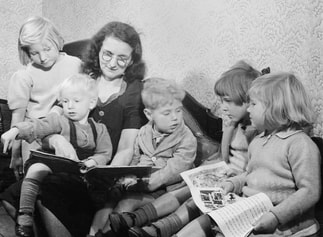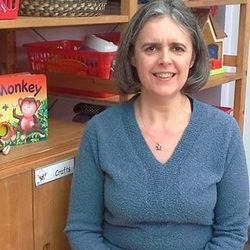Note – some childminders might have lower ratios if, for example, they have a small house, a medical condition or if they have asked for less children during their registration visit. If childminders currently working to lower ratios want to increase their ratios to 6 children under 8 they must speak to Ofsted.
The EYFS also confirms in requirement 3.42: ‘if children aged four and five only attend the childminding setting before and/or after a normal school day, and/or during school holidays, they may be cared for at the same time as three other young children.’ This means that when a child starts school – and Ofsted have clarified that it’s from the first day at school (we don’t have to wait for the settling in period to end) – the child can be counted in our over 5s ratios.
The EYFS allows childminders to change the ratios and states some instances of some of the times when we can have more than 3 children under 5 (never more than 6 under 8). For example, the EYFS says we can have an extra child when: ‘caring for sibling babies, or when caring for their own baby, or to maintain continuity of care’ (EYFS requirement 3.42).
The Department for Education has also stated childminders can have an extra child if we care for a child who is doing their 3 / 4 year old funded sessions in a school nursery.
https://www.nurseryworld.co.uk/nursery-world/news/1162316/ratios-made-more-flexible-for-childminders-with-30-hours-children
Ofsted have taken the information from the EYFS and the Department for Education further and advised childminders that we can have an extra child as long as we can demonstrate to an Ofsted inspector that we are meeting their care and learning needs fully during inspection. This ensures we comply with EYFS requirement 3.40: ‘Exceptionally, and where the quality of care and safety and security of children is maintained, changes to the ratios may be made.’ Ofsted have also recently stated that a funded child does not necessarily need to be in a school nursery to be replaced in our ratios by another early years child.
This change to ratios should not mean extra record keeping for childminders – future inspections will be focused on safeguarding, health and safety and how well we deliver our early years curriculum and inspectors will ask questions and observe us during play without expecting to see reams of unnecessary documentation. Note - the amount of paperwork that will be required by Ofsted inspectors is currently under consultation (March 2019).
https://www.nurseryworld.co.uk/nursery-world/news/1166871/alliance-joins-dfe-and-ofsted-to-tackle-early-years-workload
Before childminders organise a variation, we need to consider how well we will continue to comply with the EYFS while we have extra children in the house – the focus must be on how well we will meet each child’s care and learning needs.
A risk assessment might cover the following areas of provision –
- How many children we are looking after – are we still within the 6 under 8 ratios in the EYFS?
- The reason for the variation – is it to support a child and their family or is it to earn extra money? As a general rule, Ofsted inspectors want to see how the variation is helping children and their families by, for example, offering extra sessions for a child who is already in our care.
- Floor space – it is best practice to measure the usable childminding spaces in the house and check the rooms are big enough (see EYFS requirement 3.57).
- Local planning laws – in some cases, Local Authority planning laws only allow childminders to care for 3 children under the age of 5.
- Whether the furniture and equipment available in the house and garden is sufficient for the amount of children in the setting on the day – for example, if a childminder is looking after an extra little one they may need an extra high chair or car seat.
- How well we are caring for the children - can we demonstrate during inspection that we can manage each child’s care needs well? For example, Ofsted will observe what the older children are doing if the childminder is feeding babies – are they safe, engaged and motivated in their learning?
- How effectively we will deliver the learning and development requirements of the EYFS (what Ofsted are calling our ‘curriculum’) to all the children to help them make the best possible progress. Note - this is something Ofsted will focus on during inspection, now and in the future, especially when childminders have more than 3 children under the age of 5.
- How we will support children’s behaviour – especially if we work on our own and have more than 3 children under the age of 5 at the same time. For example, what are the 4 (or more) children doing when the childminder leaves the room? How well are the babies and older children behaving together? Is older children’s behaviour impacting on the younger children’s learning?
- Informing all parents so that they understand what the change in ratios might mean for their own child’s care. This ensures we comply with EYFS requirement 3.42: ‘If a childminder can demonstrate to parents and/or carers and Ofsted inspectors that the individual needs of all the children are being met, exceptions to the usual ratios can be made.’
- How you will ensure all children are taken on outings and / or have access to the outside area as well as being engaged in indoor play.
- How well the day is organised so all children get enough of our time – this relates to our daily routine which must be shared with parents to comply with the EYFS (see EYFS requirement 3.73).
There might be other areas of your provision you need to risk assess, depending on your set-up.
Note - there is no requirement to write your risk assessment – it’s up to you if you want to record a risk assessment, permission from the local planning department, floor space check, children’s routines and planning, parent views etc. Ofsted will check you are managing the variation well when they visit you for inspection – and you do NOT need to inform Ofsted that you have extra children.
There are lots of variation questions on Facebook groups and really, given Ofsted’s relaxation of their advice on childminder ratios, the replies should be the same to them all: are you childminding legally - ratios, floor space, planning permission etc? Are you absolutely sure you can manage each child’s care and learning needs fully? Would you be happy demonstrating children’s care and learning with that exact combination of children during an Ofsted inspection? Can you give each child your best attention when you have more than 3 children under 5 by yourself?
The Ofsted Facebook page ‘Childcare Registration’ contains useful information and will answer individual questions about ratios - https://www.facebook.com/ChildcareRegistration/
Disclaimer - please note - I have done my best using as up-to-date information as I can find BUT every Ofsted inspector will have their own viewpoint on your ratios and how well you are managing them. If your Ofsted inspector decides you are not managing the variation well, then they will tell you that you are working over ratio.
I hope this helps, Sarah
Knutsford Childminding - www.knutsfordchildminding.co.uk



 RSS Feed
RSS Feed
